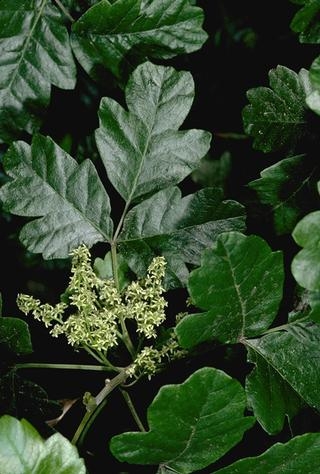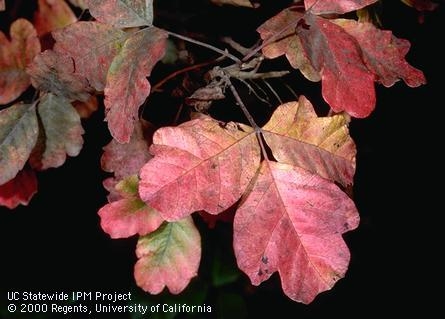Controlling Poison Oak With Herbicides
Help for the Home Gardener from the Help Desk of the
UC Master Gardener Program of Contra Costa County
Help Desk Client: I have yet to landscape the hillside in my back garden. It has an extensive stand of poison oak. I've sprayed herbicide on it before several years ago, but it has resprouted and returned as extensive as ever. I would like to landscape the hillside sometime soon. What can I do to eradicate the poison oak completely and hopefully easily?
Help Desk Response: Thank you for contacting the UC Master Gardener Program Help Desk with your question about managing poison oak (Toxicodendron diversilobum) on your back yard hillside that has yet to be landscaped. Poison oak thrives in uncultivated areas so it is not surprising that you would have a healthy population of it on your hillside.
Poison oak eradication and control can be a formidable task, especially for a home gardener.
University of California guidance is: “The primary ways of managing poison oak are mechanical removal by hand pulling, which is not recommended for individuals who are sensitive to this plant, and treatment with herbicides. Maintaining a healthy cover of desirable vegetation will reduce potential invasion. This is easiest where you have available irrigation and regularly cultivated soil.”
You mentioned that herbicide had been applied several years ago but that the poison oak has grown back. Unfortunately, one application of herbicide is not expected to control poison oak. It will resprout, and the new growth should be treated again. The timing of herbicide treatment is also important for effectiveness, and different herbicides have different optimal application timing related to the plant growth stage.
Spraying the leaves with herbicide is most effective after leaves are fully developed and when the plant is actively growing. This period is normally from April into June or July, when soil moisture is still adequate.
Herbicides used to control poison oak in California include glyphosate (Roundup, etc.); the auxinic herbicides triclopyr (Garlon, Ortho Brush-B-Gon, etc.); 2,4-D (Brush Buster Woody Plant Herbicide, etc.); a combination of 2,4-D and dicamba (Spectracide Brush Killer Spray Concentrate, Spectracide Poison Ivy & Poison Oak Brush Killer, and Ortho Weed B Gon Max); or a combination of glyphosate and imazapyr (Ortho Groundclear Vegetation Killer).
Glyphosate is one of the most effective herbicides for controlling poison oak. However, effective control depends upon the proper timing of the application. Apply glyphosate late in the growth cycle, after the fruit has formed but before leaves have lost their green color. Be sure to check the product label before you buy: you should apply glyphosate as a 2% solution in water. Products or spray mixtures containing less than 2% glyphosate may not effectively control poison oak.
Auxinic herbicides such as triclopyr, 2,4-D, dicamba, and combinations of these herbicides also control poison oak. You can apply these herbicides earlier than glyphosate when plants are growing rapidly from spring to midsummer.
If you want to begin controlling the poison oak right away, we recommend that you use triclopyr, 2,4-D, dicamba, or combinations of these herbicides, as described above. If you want to wait until later, or if you treat now and then there is resprouting later in the season, a 2% solution of glyphosate would be your best choice.
Be sure to follow all label directions when using a herbicide, and take precautions to avoid endangering yourself, other persons, pets, wildlife, and sensitive plants that you do not wish to kill. A discussion of precautions can be found at this University of California website: http://ipm.ucanr.edu/PMG/PESTNOTES/warning.html.
Additional information about poison oak can also be found here http://ipm.ucanr.edu/PMG/PESTNOTES/pn7431.html.
I hope that this information is helpful.
Help Desk of the UC Master Gardener Program of Contra Costa County (JL)
Note: The UC Master Gardeners Program of Contra Costa's Help Desk is available year-round to answer your gardening questions. Except for a few holidays, we're open every week, Monday through Thursday for walk-ins from 9:00 am to Noon at 75 Santa Barbara Road, 2d Floor, Pleasant Hill, CA 94523. We can also be reached via telephone: (925) 646-6586, email: ccmg@ucanr.edu, or on the web at http://ccmg.ucanr.edu/Ask_Us/ MGCC Blogs can be found at http://ccmg.ucanr.edu/HortCoCo/ You can also subscribe to the Blog (//ucanr.edu/blogs/CCMGBlog/).










or http://bayareane.ws/2sXitUh
Should give you second thoughts wandering off trails, etc.this year.
Posted by Steve Morse on June 21, 2017 at 7:11 PM